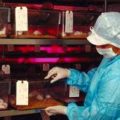
A particle with no charge, a very low mass and a lifetime much shorter than a nanosecond, known as the axion, has been detected by the University at Buffalo (UB) physicist who first suggested its existence 30 years ago. Piyare Jain, UB professor emeritus in the Department of Physics and lead investigator on the research, will have his work on the axion published in the British Journal of Physics G: Nuclear and Particle Physics in January.
The axion has been viewed as an integral part of the Standard Model of Physics and is believed to be a component of much of the dark matter in the universe. “These results show that we have detected axions, part of a family of particles that likely also includes the very heavy Higgs-Boson particle, which at present is being sought after at different laboratories,” said Jain.
The axion story begins in 1974, during particle accelerator experiments Jain conducted at Fermilab and Brookhaven National Laboratory, which provided tantalizing glimpses of particles with very low mass and very short lifetimes. “This particle was there in my original paper in 1974,” Jain said. “The experiment gave a hint that these particles existed but did not generate sufficient statistics to prove it.
In the late ’70s, both theoretical and experimental physicists took up the hunt for the particle, but many in the physics community abandoned the search in the 1990s, on the basis of puzzling evidence that suggested the axion didn’t exist after all. In fact, some research groups flatly denied its existence and began referring to it as a “phantom.”
The CERES experiment at CERN took up the search in 1999, but that project also was unsuccessful. The problem, according to Jain, was with their detector, which was electronic, the standard used in high-energy physics experiments today. “They didn’t know how to handle the detector for short-lived particles,” Jain explained. “I knew that for this very short-lived particle – 10 to the power minus 13 seconds – the detector must be placed very near the interaction point where the collision between the projectile beam and the target takes place so that the produced particle doesn’t run away too far; if it does, it will decay quickly and it will be completely missed. That is what happened in most of the unsuccessful experiments.”
Rather than an electronic detector, Jain used a visual detector, made of three-dimensional photographic emulsions, which act as both target and detector and can detect very short-lived particles, such as the axion. Jain used such a detector in tandem with a heavy ion lead beam with a total energy of 25 trillion electron volts at CERN, in Geneva, to find the axion.
Jain’s experiments generated 1,220 electron pairs with identified vertices, the origin of each pair. They peaked at a distance of just 200-300 microns from the interaction point where the collisions take place in the emulsion. “Only at that very short distance did I find the peak signal of this very-low-mass, short-lived particle with a neutral charge,” he said. After they are produced, axions rapidly decay into two electron pairs, the electron and the positron, he explained. “We identified each vertex for each electron pair and we would not accept any electron pair unless we knew its vertex. There was a congestion of all kinds of low mass particles, including axions, near the detector. The background has to be filtered out from this congestion in order to obtain the signal of the axion.”
Out of the 175 scientific papers he has had published, Jain says that the detection of the axion is the most satisfying work he has accomplished. “After half a century as a scientist at UB, I find that with the discovery of this axion, my mission is complete,” he said.













Comments are closed.